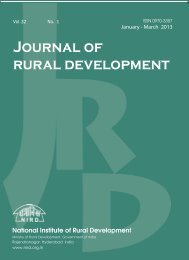Issue for October - December 2011 - National Institute of Rural ...
Issue for October - December 2011 - National Institute of Rural ...
Issue for October - December 2011 - National Institute of Rural ...
You also want an ePaper? Increase the reach of your titles
YUMPU automatically turns print PDFs into web optimized ePapers that Google loves.
428 A.K. Jain, M. Gopinath Reddy and M.S. Rama Mohan RaoThere is a priority need to strengthen thecapacities and skills <strong>of</strong> stakeholders in the area<strong>of</strong> their interest to trans<strong>for</strong>m them into selfmanagers(Fig-1) which requires considerabletime and effective training at different levels(Shah 1998, Crispin Lobo, 2009 and Sivanna,Gopinath Reddy and Srinivasa Reddy, 2007).Fig. 1 : Process <strong>of</strong> Planning & Development <strong>of</strong> Watershed by the Local Level InstitutionThe available theory and practice suggestthat small homogeneous groups representingfull spectrum <strong>of</strong> stakeholders can carry outimplementation tasks better than big groupsor committees (Mukherjee, 1998; Rajasekharet al, 2003; Sreenath Dixit et al, 2007). Henceat the watershed level, it is necessary to buildaffinity groups having focus on poverty,livelihoods, water management, soilmanagement, crop management, CPRmanagement etc. By training such groups, itwill be possible to effectively plan andimplement the programmes.Such a programme demands an effectivetraining organisation located at the districtlevel, depicting the resources, problems andprospects along with technical solutions.Towards this end, it is essential to develop aDistrict Resource Centre at each districtmanaged by multi-disciplinary team, withcomplete in<strong>for</strong>mation related to bio-physical,geo-hydrological and socio-economics <strong>of</strong> thearea (Fig-2). Such knowledge helps inassessing the potential capabilities andweaknesses. The centre should also have aflow <strong>of</strong> in<strong>for</strong>mation with respect totechnologies <strong>for</strong> resource conservation,livelihood opportunities related to resourcesand present alternative land uses along withefficient management practices apart fromvarious developmental programmes and theiractivities in the district. The centre must beable to provide both resource and functionalliteracy at the watershed level along withapplicable knowledge system that arelocation-specific. The centre should act as agood training facility <strong>for</strong> stakeholders onappropriate methods, workable technologiesand organisational skills. Since watershedJournal <strong>of</strong> <strong>Rural</strong> Development, Vol. 30, No. 4, <strong>October</strong> - <strong>December</strong> : <strong>2011</strong>
















